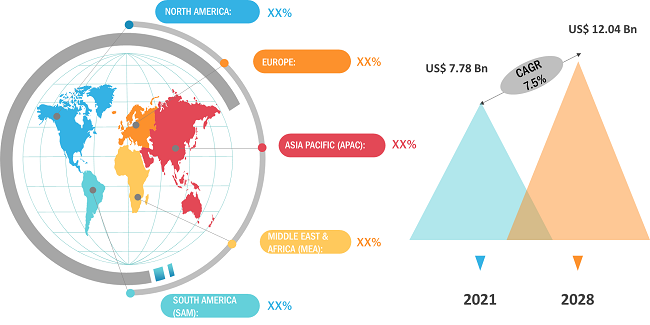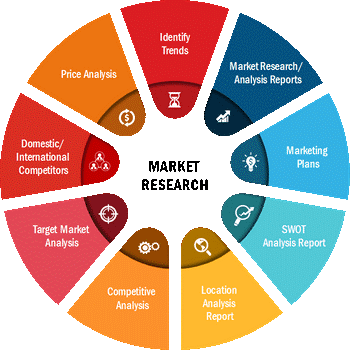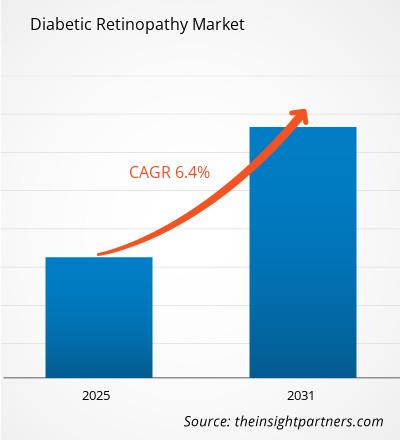糖尿病網膜症市場は2021年の77億8000万米ドルから2031年までに120億4000万米ドルに増加すると予想される。 2022 年から 2031 年にかけて 6.5% の CAGR で成長すると予想されています。
糖尿病は、最も一般的に診断される非感染性疾患の 1 つです。糖尿病の発生率の増加は、糖尿病性網膜症 の増加が原因であると考えられています。 ; 市場。糖尿病網膜症は、糖レベルが高くなると網膜が損傷されるため、かすみ目や失明が特徴です。 糖尿病性網膜症は、高血糖によって網膜が損傷されるため、かすみ目や失明が特徴です。米国疾病管理予防センター (CDC) のデータによると、40 歳以上の糖尿病患者の約 3 分の 1 が糖尿病性網膜症に罹患しており、現在米国には 420 万人以上の患者が糖尿病性網膜症を患って住んでいます。その結果、市場リーダーは糖尿病性網膜症の革新的な治療法の開発に取り組んでおり、さまざまな新しい関連治療法が研究中です。たとえば、2021 年 5 月に、Regeneron Pharmaceuticals, Inc. は EYLEA® の FDA 承認を取得しました。 (アフリベルセプト) 糖尿病性網膜症の治療のための注射。
市場のダイナミクス
糖尿病網膜症市場の成長はその主な原因は、糖尿病の有病率の増加、高齢者人口の増加、および糖尿病性網膜症の症例の増加です。しかし、医薬品の承認の遅れと熟練した眼科医の不足が市場の成長を妨げています。
市場範囲
「2031 年までの世界の糖尿病性網膜症市場分析」レポートは、種類、治療法、流通チャネルに基づいた詳細な市場分割とともに、糖尿病性網膜症市場の概要を提供することを目的としています。このレポートは、主要企業の業績に基づいた主要な市場統計を提供します。また、市場の主要なトレンドと機会も提供します。
戦略的洞察
市場セグメンテーション
世界の糖尿病性網膜症市場は、種類、治療法、分布別に分類されています。タイプに基づいて、市場は増殖性糖尿病性網膜症と非増殖性糖尿病性網膜症に分かれます。治療法に基づいて、市場は抗 VEGF 薬、ステロイドに分類されます。注射、レーザー手術、 硝子体手術。流通チャネルに基づいて、市場は小売薬局、病院薬局などに分類されます。
< span style="font-family: verdana, Geneva, sans-serif; font-size: 10pt;">地域枠組み
世界の糖尿病性網膜症市場は、北米、ヨーロッパ、アジア太平洋、中東、中東の 5 つの主要地域に分割されています。アフリカ、そして南と南。中米。このレポートでは、世界 18 か国の分析と予測、およびこれらの地域で普及している傾向と機会を取り上げています。
北米は、2021 年に約 38% のシェアを獲得し、糖尿病網膜症市場を独占しました。この地域の市場成長は、巨大な糖尿病人口の存在に加え、以下のような主要な市場プレーヤーの存在に主に起因しています。アボット・ラボラトリーズ、アリメラ・サイエンス、アラガン社、リジェネロン・ファーマシューティカルズ社、ファイザーなど。以下の図は、北米の糖尿病性網膜症市場の収益成長傾向を示しています。
 出典: Insight Partners 分析 >
出典: Insight Partners 分析 >
レポートでは、推進力、制約、機会などの影響要因を分析しています。 、 糖尿病性網膜症 市場に影響を与える将来の傾向。また、糖尿病網膜症市場に影響を与える要因の徹底的な PEST 分析も提供します。
新型コロナウイルス感染症のパンデミックの影響
新型コロナウイルス感染症(COVID-19)のパンデミックは、糖尿病性網膜症市場に悪影響を及ぼしました。これにより、医療施設、特に眼科クリニックの混乱が生じた。パンデミック中に外来患者が減少したため、糖尿病性網膜症の診断が遅れ、最終的には糖尿病性網膜症治療薬の需要が減少しました。 Strata Decision Technology の調査によると、眼科市場は新型コロナウイルス感染症の第 1 波で販売量シェアの 81% を失いました。さらに、パンデミック中に糖尿病網膜症患者の約 30% がクリニックを受診できませんでした。
さらに、製造部門の閉鎖、経済の急激な低迷、全国的なロックダウン、物流施設の閉鎖、臨床試験の遅延、診断手順の減少も、糖尿病性網膜症の需要減少の主な要因となっている。営業活動の延期、先端製品を発売するためにリーダーが行った研究開発活動の削減、患者が経験した経済的挫折により、2021年の市場成長は劇的に鈍化しました。しかし、市場は2022年半ばまでに回復すると予測されています。新型コロナウイルス感染症の流行期間中に患者では糖尿病の進行が観察され、最終的には糖尿病性網膜症の発生率が上昇することになる。これに加えて、2022 年の最初の四半期における主要な糖尿病性網膜症治療薬の好成績も、糖尿病性網膜症市場の回復を示しています。
市場参加者
このレポートでは、糖尿病性網膜症市場の主要な動向について取り上げています。さまざまな企業が、製品の発売、製品の承認、特許、イベントなどの有機的な成長戦略に注力しています。買収、パートナーシップ、コラボレーションなどの無機的な成長戦略は、市場プレーヤーのビジネスと顧客ベースの拡大を促進してきました。糖尿病性網膜症 市場で活動する市場関係者は、糖尿病性網膜症治療薬の需要の高まりにより、今後数年間で有利な成長機会を経験すると予想されます。
このレポートには、主要な糖尿病性網膜症市場企業のプロフィールと、SWOT 分析および市場戦略も含まれています。また、企業概要、提供されるコンポーネントとサービス、過去 3 年間の財務情報、過去 5 年間の主な開発などの情報を提供する業界の主要企業にも焦点を当てています。糖尿病性網膜症治療薬市場に携わる数社のリストを以下に示します。
- アボット ラボラトリーズ
- アリメラ サイエンス
- Allergan Plc
- アンピオ ファーマシューティカルズ
- バイエル AG
- F. ホフマン-LA ロッシュ
- ノバルティス インターナショナル AG
- ファイザー
- Regeneron Pharmaceuticals Inc
- ヴァリアント ファーマシューティカル
Insight Partner の専任の調査分析チームは、高度な統計専門知識を持つ経験豊富な専門家で構成されており、既存の調査にさまざまなカスタマイズ オプションを提供します。

- 過去2年間の分析、基準年、CAGRによる予測(7年間)
- PEST分析とSWOT分析
- 市場規模価値/数量 - 世界、地域、国
- 業界と競争環境
- Excel データセット


- Batter and Breader Premixes Market
- Military Rubber Tracks Market
- Digital Pathology Market
- Architecture Software Market
- Third Party Logistics Market
- Vision Guided Robotics Software Market
- Visualization and 3D Rendering Software Market
- Small Molecule Drug Discovery Market
- Fertilizer Additives Market
- MEMS Foundry Market

Report Coverage
Revenue forecast, Company Analysis, Industry landscape, Growth factors, and Trends

Segment Covered
This text is related
to segments covered.

Regional Scope
North America, Europe, Asia Pacific, Middle East & Africa, South & Central America

Country Scope
This text is related
to country scope.
よくある質問
The diabetic retinopathy market is estimated to grow with a CAGR of 6.4% from 2023 to 2031
The diabetic retinopathy market majorly consists of players such as Abbott Laboratories, Alimera Science, Allergan Plc among others
Asia-Pacific region is likely to witness the fastest growth rate during the forecast period.
The market drivers include the increasing prevalence of diabetes and rising geriatric population, which are driving the diabetic retinopathy market
Personalised medicine is likely to remain the key trend during the forecast period.
North America dominated the diabetic retinopathy market in 2023
Trends and growth analysis reports related to Life Sciences : READ MORE..
The List of Companies
- Abbott Laboratories
- Alimera Science
- Allergan Plc
- Ampio Pharmaceuticals
- Bayer AG
- F. Hoffmann-LA Roche
- Novartis International AG
- PFIZER
- Regeneron Pharmaceuticals Inc
- Valeant Pharmaceutical
The Insight Partners performs research in 4 major stages: Data Collection & Secondary Research, Primary Research, Data Analysis and Data Triangulation & Final Review.
- Data Collection and Secondary Research:
As a market research and consulting firm operating from a decade, we have published and advised several client across the globe. First step for any study will start with an assessment of currently available data and insights from existing reports. Further, historical and current market information is collected from Investor Presentations, Annual Reports, SEC Filings, etc., and other information related to company’s performance and market positioning are gathered from Paid Databases (Factiva, Hoovers, and Reuters) and various other publications available in public domain.
Several associations trade associates, technical forums, institutes, societies and organization are accessed to gain technical as well as market related insights through their publications such as research papers, blogs and press releases related to the studies are referred to get cues about the market. Further, white papers, journals, magazines, and other news articles published in last 3 years are scrutinized and analyzed to understand the current market trends.
- Primary Research:
The primarily interview analysis comprise of data obtained from industry participants interview and answers to survey questions gathered by in-house primary team.
For primary research, interviews are conducted with industry experts/CEOs/Marketing Managers/VPs/Subject Matter Experts from both demand and supply side to get a 360-degree view of the market. The primary team conducts several interviews based on the complexity of the markets to understand the various market trends and dynamics which makes research more credible and precise.
A typical research interview fulfils the following functions:
- Provides first-hand information on the market size, market trends, growth trends, competitive landscape, and outlook
- Validates and strengthens in-house secondary research findings
- Develops the analysis team’s expertise and market understanding
Primary research involves email interactions and telephone interviews for each market, category, segment, and sub-segment across geographies. The participants who typically take part in such a process include, but are not limited to:
- Industry participants: VPs, business development managers, market intelligence managers and national sales managers
- Outside experts: Valuation experts, research analysts and key opinion leaders specializing in the electronics and semiconductor industry.
Below is the breakup of our primary respondents by company, designation, and region:

Once we receive the confirmation from primary research sources or primary respondents, we finalize the base year market estimation and forecast the data as per the macroeconomic and microeconomic factors assessed during data collection.
- Data Analysis:
Once data is validated through both secondary as well as primary respondents, we finalize the market estimations by hypothesis formulation and factor analysis at regional and country level.
- Macro-Economic Factor Analysis:
We analyse macroeconomic indicators such the gross domestic product (GDP), increase in the demand for goods and services across industries, technological advancement, regional economic growth, governmental policies, the influence of COVID-19, PEST analysis, and other aspects. This analysis aids in setting benchmarks for various nations/regions and approximating market splits. Additionally, the general trend of the aforementioned components aid in determining the market's development possibilities.
- Country Level Data:
Various factors that are especially aligned to the country are taken into account to determine the market size for a certain area and country, including the presence of vendors, such as headquarters and offices, the country's GDP, demand patterns, and industry growth. To comprehend the market dynamics for the nation, a number of growth variables, inhibitors, application areas, and current market trends are researched. The aforementioned elements aid in determining the country's overall market's growth potential.
- Company Profile:
The “Table of Contents” is formulated by listing and analyzing more than 25 - 30 companies operating in the market ecosystem across geographies. However, we profile only 10 companies as a standard practice in our syndicate reports. These 10 companies comprise leading, emerging, and regional players. Nonetheless, our analysis is not restricted to the 10 listed companies, we also analyze other companies present in the market to develop a holistic view and understand the prevailing trends. The “Company Profiles” section in the report covers key facts, business description, products & services, financial information, SWOT analysis, and key developments. The financial information presented is extracted from the annual reports and official documents of the publicly listed companies. Upon collecting the information for the sections of respective companies, we verify them via various primary sources and then compile the data in respective company profiles. The company level information helps us in deriving the base number as well as in forecasting the market size.
- Developing Base Number:
Aggregation of sales statistics (2020-2022) and macro-economic factor, and other secondary and primary research insights are utilized to arrive at base number and related market shares for 2022. The data gaps are identified in this step and relevant market data is analyzed, collected from paid primary interviews or databases. On finalizing the base year market size, forecasts are developed on the basis of macro-economic, industry and market growth factors and company level analysis.
- Data Triangulation and Final Review:
The market findings and base year market size calculations are validated from supply as well as demand side. Demand side validations are based on macro-economic factor analysis and benchmarks for respective regions and countries. In case of supply side validations, revenues of major companies are estimated (in case not available) based on industry benchmark, approximate number of employees, product portfolio, and primary interviews revenues are gathered. Further revenue from target product/service segment is assessed to avoid overshooting of market statistics. In case of heavy deviations between supply and demand side values, all thes steps are repeated to achieve synchronization.
We follow an iterative model, wherein we share our research findings with Subject Matter Experts (SME’s) and Key Opinion Leaders (KOLs) until consensus view of the market is not formulated – this model negates any drastic deviation in the opinions of experts. Only validated and universally acceptable research findings are quoted in our reports.
We have important check points that we use to validate our research findings – which we call – data triangulation, where we validate the information, we generate from secondary sources with primary interviews and then we re-validate with our internal data bases and Subject matter experts. This comprehensive model enables us to deliver high quality, reliable data in shortest possible time.

 このレポートの無料サンプルを入手する
このレポートの無料サンプルを入手する